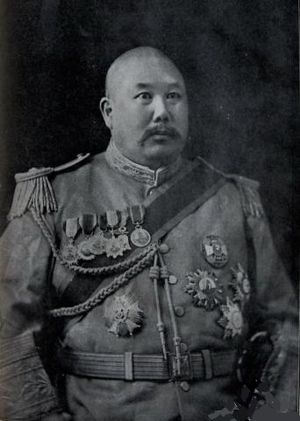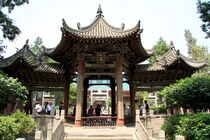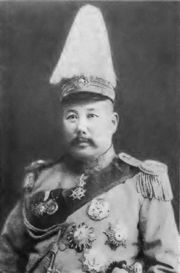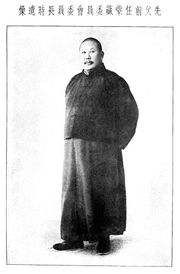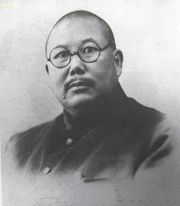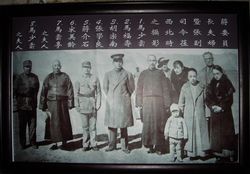ما فوشيانگ
- هذا هو اسم صيني; لقب العائلة هو ما.
| ||||||||||||||||||||||||||||||||||||||||||||||||||||||||||||||||||||||||||||||||||
| ||||||||||||||||||||||||||||||||||||||||||||||||||||||||||||||||||||||||||||||||||
ما فوشيانگ (الصينية التقليدية: 馬福祥; الصينية المبسطة: 马福祥; پنين: Mǎ Fúxiáng; Wade–Giles: Ma Fu-hsiang الرومنة الفرنسية: Ma-Fou-hiang أو Ma Fou-siang;[4]؛ إنگليزية: Ma Fuxiang؛ عاش 1876 – 19 أغسطس 1932) كان قائداً عسكرياً وسياسياً صينياً في عهد أسرة تشينگ وفي مطلع جمهورية الصين مما يبيّن سطوة عائلته، ودور العائلة وقوتها ودور الانتماء الديني وتفاعل آسيا الداخلية الصينية والحكومة الوطنية الصينية.[5] وقد كان أمير حرب مسلم بارز في شمال غرب الصين.[6][7] وقد خدم ما فوشيانگ، في بادئ الأمر، تحت إمرة دونگ فوشيانگ، مثل باقي أمراء الحرب أعضاء عصابة ما مثل ما آنليانگ.[8]
وُلِد ما في لنشيا، گانسو. وقد عـُيـِّن حاكماً عسكرياً على شيننگ، ثم على ألطاي، في عهد أسرة تشينگ. وقد تولى عدداً كبيراً من المناصب العسكرية في المنطقة الشمالية الغربية بعد تأسيس الجمهورية. وقد أصبح حاكماً على چينگهاي في 1912، نينگشيا من 1912 حتى 1920، وسوييوان من 1920 حتى 1925. ولما تحول لصف تشيانگ كاي-شك في 1928، فقد أصبح رئيس (حاكم) حكومة آنهوي في 1930.[9] ثم اُنتُخِب عضواً في مفوضية الحكومة الوطنية، ثم عُيـِّن عمدة چینگداو، البلدية الخاصة.[10] كما كان رئيس مفوضية الشئون المنغولية-التبتية وعضو اللجنة التنفيذية المركزية للكومنتانگ. وقد توفي في أغسطس 1932.[11]
النشأة
بـِيْيانگ
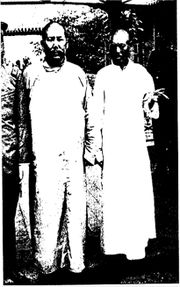
أثناء ثورة شينهاي في 1912, حمى ما فوشيانگ الإرسالية الكاثوليكية من هجمات Gelaohui في Sandaohe district, and he also protected another Catholic mission from attacks in 1916.[3][12] He and his nephew Ma Hongbin received the Order of Leopold (Belgium) ("King Leopold decoration") for their work.
كتاب ما فوشيانگ، "Shuofang Daozhi", يصوّر تلك الأحداث. وثمة رواية للأحداث من الفرنسي Harry Serruys تصفه.
"ما فوشيانگ، قائد جيش الحماية، أرسل ما فوشو، رئيس أركان الجيش العسكري اللامع، ليهاجم اللصوص في معبد زوؤتشا. ما فوشيانگ dispatched Fushou with an army to attack Kao's army at Zuuqa temple and destroyed the band. In the second month of 1917 ما فوشيانگ executed Wu Daer Liuji. ما فوشيانگ dispatched his nephew Ma Hongbin to attack Kao and Wu at Shizuishan. When Liu-chi was defeated, ما فوشيانگ ambushed him and defeated him again. ما فوشيانگ captured Yu Ling-yun, Su Xuefeng, Yao Zhankui, Zhang Zhenqing, Li Zongwen and several others; in all 18 men were executed. ما فوشيانگ wrote a commemorative inscription for men من نينگشيا who died in the expedition against the bogus Emperor. In the third month of the sixth year of the Republic [1917], ما فوشيانگ was at the burial of his mother. As he reached Ning'anbu Ma Hongbin sent him a telegram stating that the bogus emperor and the other bogus generals had mounted an invasion من سوييوان. After the victory, officers in charge of military headquarters and regular soldiers were honored."[13]
هزم ما فوشيانگ brigands near Sandaohe (San-Tao-Ho) وطردهم من نينگشيا، حسب المبشر الكاثوليكي البلجيكي J. Terstappen في 1915.[9]
علاقات الخان مع الخوي تحسنت كثيراً في عهد ما فوشيانگ في نينگشيا بسبب سياساته.[14]
ما فوشيانگ وزعيم الطريقة الجهرية الصوفية ما يوانژانگ أصبحا عدوين بعد غضب ما فوشيانگ العارم لرفض ما يوانژانگ مساعدته في الاطاحة بـ ژانگ گوانگجيانگ من منصب حاكم گانسو وأبرق إلى بكين أن ژانگ يجب أن يبقى حاكماً. ما فوشيانگ وجنرالات گانسو الآخرون كانوا مؤمنين بأن شخصاً من أبناء مقاطعة گانسو يجب أن تولى منصب حاكمها وليس غريباً.[15][16] ما فوشيانگ، نفسه، كان يُعتبر أكثر الأشخاص استحقاقاً لتولي منصب حاكم گانسو بعد فترة ژانگ الفاشلة، لسبب خبرته العسكرية في عهدي أسرة تشينگ وجمهورية الصين، وحكمه في نينگشيا.[17]
وقد استثمر في تجارة الصوف وفي مصنع أعواد ثقاب.
ما فوشيانگ effectively took Ma Anliang's place as de facto leader of Muslims in northwest China when Ma Anliang died in 1918.[8][18]
كومنتانگ
وفي 1924، التقى ما فوشيانگ بزعيم الكومنتانگ الدكتور صن يات-سن in Beijing and informed him that he would welcome the leadership of Dr. Sun.[19]
الجيش
تهريب المخدرات
ازدهرات تجارة الأفيون في مقاطعة سوييوان في الحقبة الجمهورية بالصين.[20]
Opium (poppy) farming was already thriving في سوييوان by the time ما فوشيانگ became the military governor in 1921, due to the fact that soldiers were not being paid their salaries at all, so they resorted to dealing with opium farmers to make money.[21] زراعة الخشخاش حظرها ما فوشيانگ في گانسو، إلا أنه اعترف حين عُـيـِّن حاكماً عسكرياً على سوييوان أنه لما كانت تجارة الأفيون مزدهرة بشكل كبير في سوييوان، that he both could not and would not deal with he situation.[22]
In 1923, an officer of the بنك الصين من باوتو found out that ما فوشيانگ was assisting the drug trade in opium which helped finance his military expenses. He earned a sum of $2 million from taxing those sales in 1923. General Ma had been using the Bank, a branch of the Government of China's exchequer, to arrange for silver curreny to be transported to Baotou to use it to sponsor the trade.[23][24]
While Ma caused opium to become rampant due to his support for the cultivation of opium and its trade في سوييوان، he also enabled policies which benefited the residents في سوييوان، filling posts in military, educational, and administrative manners بأشخاص من سوييوان and expanding education.[25]
رجل البر والتعليم
ما فوشيانگ، مع ما لينيي، تكفل بنفقات حج الإمام وانگ جينگژاي إلى مكة المكرمة في 1921.[26][27]
دعم ما فوشيانگ الإمام هو سونگشان.[28]
أكاديمية چنگدا للمعلمين من مسلمي الخوي دعمها ما فوشيانگ، مع مسئولين مسلمين آخرين من الكومنتانگ. مالية أكاديمية چنگدا للمعلمين كانت مرتبطة بإصلاح التعلم وغرس الروح الوطنية الصينية في مسلمي الخوي.[29]
وقد بنى ما العديد من المدارس الابتدائية والثانوية للمسلمين في أرجاء شمال غرب الصين. وقد أسس جمعية ترويج التعاليم الإسلامية في 1918 في العاصمة الإقليمية گانسو.[30] For the purpose of educating and building a class of intellectuals among the Hui in northwest China, Beijing's Xibei Gongxue (the Northwestern Middle School) and the Yuehua were financed by Ma Fuxiang. He believed that modern education would help Hui Chinese build a better society and help China resist foreign imperialism and help build the nation. He had both the military authority and economic power to help fund education. Until he died in 1932, 100 yuan every month was donated by him for education.[31] وقد أسس مكتبة عامة في نينگشيا، ورعى مختلف المدارس الإسلامية. He was a Chinese nationalist and a Confucianist, and was praised for his "guojia yizhi" (national consciousness) by non-Muslims. He also invested in new editions and reprintings of Confucian and Islamic texts.[32][33][34] وقد حرر "Shuofang Daozhi".[35] المجلة، وكتب مثل "Meng Cang ZhuangKuang: Hui Bu Xinjiang fu".[36][37]
الأيديولوجية
Ma had an interest in Chinese classical learning and western engineering and science. He thought his own Hui people fiercely loyal but "primitive" and lacking in "the educational and political privileges of the Han Chinese".[38] Ma encouraged Huis to assimilate into Chinese civilization and culture,[39] and created the Assimilationist Group to promote this idea.[40] ما فوشيانگ's assimilationist organization a mix of Islam and Confucianism with Hui being considered an integral part of China, the name of this organization was the Assimilationist (Neixiang) clique.[41]
الأسرة
منغوليا والتبت
ما فوشيانگ، كرئيس لمفوضية الشئون المنغولية والتبتية،[42] ألقى تصريحاً بأن كلاً من منغوليا والتبت هما أجزاء من جمهورية الصين:
إن حزبنا [ الگومندانگ ] يؤمن بتنمية الضعيف الفقير ومقاومة القوي العنيف كروح الأمة وكمهمة عاجلة. وهذا أكثر حقيقةً لتلك المجموعات التي هي ليست من عرقنا [Ch. fei wo zulei zhe]. والآن فإن الشعوب [مينزو] في منغوليا والتبت هم أقارب حميمون لنا، ونكن عظيم المودة لبعضنا البعض: our common existence and common honor already have a history of over a thousand years.... Mongolia and Tibet's life and death are China's life and death. China absolutely cannot cause Mongolia and Tibet to break away from China's territory, and Mongolia and Tibet cannot reject China to become independent. At this time, there is not a single nation on earth except China that will sincerely develop Mongolia and Tibet."[43]
في 1930 التقى ما مع التبتي dKon-mchog-gro-nyi للتباحث في أمور التبت، حيث أنه فوّض dKon-mchog-gro-nyi للتواصل مع الدالاي لاما الثالث عشر حول قضية الپانچن لاما التاسع، الذي فر من التبت وانضم للحكومة الصينية بعد خلاف مع الدالاي لاما الثالث عشر.[44] وقد أرسل الدالاي لاما رسالة إلى ما فوشيانگ في 28 ديسمبر 1930، يتهم فيها أتباع الپانچن لاما بإثارة أمراء الحرب في سيچوان أثناء الحرب التبتية الصينية.[45]
أثناء الحرب التبتية الصينية، ما فوشيانگ، كرئيس مفوضية الشئون المنغولية والتبتية، أبرق إلى المسئول المسلم في الكومنتانگ تانگ كسان يأمره بخرق الاتفاقية مع التبت، لأن كان قلقاً من أن الخصوم السياسيين في الكومنتانگ في نانجينگ كانوا يستخدمون الحادث لمآربهم الشخصية.[46][47]
افتتح ما فوشيانگ جلسة مؤتمر الشئون المنغولية في 1931 بخطبة افتتاحية. وفي المؤتمر، أدانت الصين انفصال تانـّو توڤا عن منغوليا الخارجية على يد السوڤيت.[48] Ma then led the closing ceremony of the conference on 12 July.[49]
وفاته
توفي ما فوشيانگ بالقرب من Lianghsiang, 19 August 1932, while he was traveling to Beijing to receive medical treatment, from Chikungsan around Hankou.[50]
انظر أيضاً
الهامش
- ^ "青岛首任市长马福祥". qingdaonews.com. 29 June 2014. Retrieved 13 August 2015.
{{cite web}}: Unknown parameter|trans_title=ignored (|trans-title=suggested) (help) - ^ أ ب Schram, Stuart R., ed. (1992). Mao's Road to Power - Revolutionary Writings, 1912-1949: The Pre-Marxist Period, 1912-1920, Volume 1. Vol. vol. 5 (illustrated ed.). M.E. Sharpe. p. 62. ISBN 1563244578. Retrieved 24 April 2014.
{{cite book}}:|volume=has extra text (help); Invalid|ref=harv(help) - ^ أ ب Ann Heylen (2004). Chronique du Toumet-Ortos: looking through the lens of Joseph Van Oost, missionary in Inner Mongolia (1915–1921). Leuven, Belgium: Leuven University Press. p. 203. ISBN 90-5867-418-5. Retrieved 28 June 2010.
- ^ Heylen, Ann (2004). Chronique Du Toumet-Ortos: Looking Through the Lens of Joseph Van Oost, Missionary in Inner Mongolia (1915-1921). Vol. Volume 16 of Louvain Chinese studies (illustrated ed.). Leuven University Press. p. 373. ISBN 9058674185. Retrieved 24 April 2014.
{{cite book}}:|volume=has extra text (help); Invalid|ref=harv(help) - ^ Howard L. Boorman, Richard C. Howard, eds., Biographical Dictionary of Republican China (New York: Columbia University Press, 1968) Vol 2, pp. 464-65.
- ^ Andrew, G. Findlay (1921). The Crescent in North-West China. With Illustrations. Retrieved 24 April 2014.
{{cite book}}: Invalid|ref=harv(help) - ^ Harris, Fred (2007). The Arabic Scholar's Son: Growing Up in Turbulent North China (1927-1943). AuthorHouse. p. 53. ISBN 1467822337. Retrieved 24 April 2014.
{{cite book}}: Invalid|ref=harv(help) - ^ أ ب Chinese Republican Studies Newsletter, Volumes 1-7. Contributors University of Connecticut. Dept. of History, Denison University. Dept. of History, University of Illinois at Urbana-Champaign. Center for Asian Studies. Center for Asian Studies, University of Illinois. 1975. p. 171. Retrieved 24 April 2014.
{{cite book}}: Invalid|ref=harv(help); horizontal tab character in|others=at position 13 (help)CS1 maint: others (link) - ^ أ ب Morrison, George Ernest (1978). Lo (Luo), Hui-Min (Huimin) (ed.). The Correspondence of G. E. Morrison 1912-1920. Vol. Volume 2 of The Correspondence of G. E. Morrison, George Ernest Morrison (illustrated ed.). Cambridge University Press. p. 474. ISBN 0521215617. Retrieved 24 April 2014.
{{cite book}}:|volume=has extra text (help); Invalid|ref=harv(help) - ^ American Asiatic Association (1940). Asia: journal of the American Asiatic Association, Volume 40. Asia Pub. Co. p. 660. Retrieved 2011-05-08.
- ^ George Ernest Morrison, Hui-Min Lo (1978). The Correspondence of G. E. Morrison 1912-1920. CUP Archive. p. 474. ISBN 0-521-21561-7. Retrieved 28 June 2010.
- ^ Patrick Taveirne (2004). Han-Mongol Encounters and Missionary Endeavors: A History of Scheut in Ordos (Hetao) 1874–1911. Leuven, Belgium: Leuven University Press. p. 567. ISBN 90-5867-365-0. Retrieved 28 June 2010.
- ^ Centre d'études mongoles et sibériennes. Etudes Mongoles et Sibériennes 16. SEMS. p. 53. Retrieved 24 April 2014.
{{cite book}}: Invalid|ref=harv(help) - ^ China's Ethnic Groups, Issues 1-4. Contributor China. Guo jia min wei. Ethnic Groups Unity Publishing House. 2004. p. 217. Retrieved 24 April 2014.
{{cite book}}: Invalid|ref=harv(help); horizontal tab character in|others=at position 12 (help)CS1 maint: others (link) - ^ Lipman, Jonathan Neaman (1998). Familiar strangers: a history of Muslims in Northwest China. University of Washington Press. p. 183. ISBN 0295800550. Retrieved 24 April 2014.
{{cite book}}: Invalid|ref=harv(help) - ^ Yang, Fenggang; Tamney, Joseph, eds. (2011). Confucianism and Spiritual Traditions in Modern China and Beyond. Vol. Volume 3 of Religion in Chinese Societies (illustrated ed.). BRILL. p. 224. ISBN 9004212396. Retrieved 24 April 2014.
{{cite book}}:|volume=has extra text (help); Invalid|ref=harv(help) - ^ Lipman, Jonathan Neaman (1980). The border world of گانسو، 1895-1935. Stanford University. p. 252. Retrieved 24 April 2014.
{{cite book}}: Invalid|ref=harv(help) - ^ Travels Of A Consular Officer In North-West China. CUP Archive. p. vi. Retrieved 24 April 2014.
{{cite book}}: Invalid|ref=harv(help) - ^ 马福祥
- ^ Tighe, Justin (2005). Constructing Suiyuan: The Politics of Northwestern Territory and Development in Early Twentieth-century China. Vol. Volume 15 of Brill's Inner Asian library (illustrated ed.). Brill. pp. 69, 82, 138. ISBN 9004144668. ISSN 1566-7162. Retrieved 24 April 2014.
{{cite book}}:|volume=has extra text (help); Invalid|ref=harv(help) - ^ The Opium Trade, 1910-1941, Volume 5. Contributors Great Britain. Foreign Office, Great Britain. Public Record Office (reprint ed.). Scholarly Resources. 1974. p. 106. ISBN 084201795X. Retrieved 24 April 2014.
{{cite book}}: Invalid|ref=harv(help); horizontal tab character in|others=at position 13 (help)CS1 maint: others (link) - ^ Woodhead, Henry George Wandesforde; Bell, Henry Thurburn Montague (1923). The China Year Book. North China Daily News & Herald. p. 890. Retrieved 24 April 2014.
{{cite book}}: Invalid|ref=harv(help) - ^ Edward R. Slack (2001). Opium, state, and society: China's narco-economy and the Guomindang, 1924–1937. Honolulu: University of Hawaii Press. p. 31. ISBN 0-8248-2361-3. Retrieved 28 June 2010.
- ^ Slack, Edward R. (2001). Opium, state, and society: China's narco-economy and the Guomindang, 1924-1937 (illustrated ed.). University of Hawai'i Press. p. 31. ISBN 0824822781. Retrieved 24 April 2014.
{{cite book}}: Invalid|ref=harv(help) - ^ Niu, Jingzhong; Fu, Lina (June 2007). "Ma Fu-Xiang، حاكم سوييوان في عهد أمراء الحرب الشماليين". Journal of Inner Mongolia Normal University (Philosophy and Social Science). History Department, Inner Mongolia University, Hohhot, Inner Mongolia, China 010021. Retrieved 13 July 2014.
- ^ Stéphane A. Dudoignon, Hisao Komatsu, Yasushi Kosugi (2006). Intellectuals in the Modern Islamic World: Transmission, Transformation, Communication. Taylor & Francis. p. 315. ISBN 978-0-415-36835-3. Retrieved 28 June 2010.
{{cite book}}: CS1 maint: multiple names: authors list (link) - ^ Dudoignon, Stephane A.; Hisao, Komatsu; Yasushi, Kosugi, eds. (2006). Intellectuals in the Modern Islamic World: Transmission, Transformation and Communication. Vol. Volume 3 of New Horizons in Islamic Studies. Routledge. p. 342. ISBN 1134205988. Retrieved 24 April 2014.
{{cite book}}:|volume=has extra text (help); Invalid|ref=harv(help) - ^ Stéphane A. Dudoignon, Hisao Komatsu, Yasushi Kosugi (2006). Intellectuals in the Modern Islamic World: Transmission, Transformation, Communication. Taylor & Francis. p. 261. ISBN 978-0-415-36835-3. Retrieved 28 June 2010.
{{cite book}}: CS1 maint: multiple names: authors list (link) - ^ Mao, Yufeng (2011). "Muslim Educational Reform in 20th-Century China: The Case of the Chengda Teachers Academy". Extrême-Orient Extrême-Occident. Presses universitaires de Vincennes. 1 (33): 143–170. doi:10.4000/extremeorient.193. ISBN 9782842923341. Retrieved 9 June 2014.
- ^ Stéphane A. Dudoignon (2004). Devout Societies vs. Impious States?: Transmitting Islamic Learning in Russia, Central Asia and China Through the Twentieth Century: Proceedings of an International Colloquium Jeld in the Carré des Sciences, French Ministry of Research, Paris, November 12–13, 2001. Schwarz. p. 67. ISBN 3-87997-314-8. Retrieved 28 June 2010.
- ^ Masumi, Matsumoto (2004). "The Completion of the Idea of Dual Loyalty Towards China and Islam". Etudes orientales. Archived from the original on 2011-04-30. Retrieved 28 June 2010.
- ^ Jonathan Neaman Lipman (2004). Familiar Strangers: A History of Muslims in Northwest China. Seattle: University of Washington Press. p. 176. ISBN 978-0-295-97644-0. Retrieved 28 June 2010.
- ^ Wang, Jianping (2001). Glossary of Chinese Islamic Terms (中国伊斯兰教词汇表) (illustrated ed.). Psychology Press. p. 144. ISBN 0700706208. Retrieved 24 April 2014.
{{cite book}}: Invalid|ref=harv(help) - ^ Joseph, Suad; Najmabadi, Afsaneh (2003). Joseph, Suad; Najmabadi, Afsaneh (eds.). Encyclopedia of women & Islamic cultures, Volume 1. Contributor: Suad Joseph (illustrated ed.). Brill. p. 127. ISBN 9004132473. Retrieved 24 April 2014.
{{cite book}}: Invalid|ref=harv(help) - ^ 马福祥 (Ma Fuxiang) (1987). Shuo fang dao zhi 31st Edition(朔方道志: 31卷). Tianjin Ancient Books Publishing House (天津古籍出版社).
- ^ 馬福祥(Ma Fuxiang) (1931). 蒙藏狀况: 回部新疆坿 (Mongolian and Tibetan Affairs Status: Mikurube Xinjiang Agricultural Experiment Station). Mongolian and Tibetan Affairs Commission(蒙藏委員會).
- ^ "inauthor:"马福祥" - Google Search". google.com. Retrieved 13 August 2015.
- ^ خطأ استشهاد: وسم
<ref>غير صحيح؛ لا نص تم توفيره للمراجع المسماةclose - ^ Lipman, Jonathan N. (Jul 1984). "Ethnicity and Politics in Republican China: The Ma Family Warlords of Gansu". 10. Sage Publications, Inc.: 296. JSTOR 189017.
{{cite journal}}: Cite journal requires|journal=(help) - ^ Joseph Mitsuo Kitagawa (2002). The religious traditions of Asia: religion, history, and culture. Routledge. p. 368. ISBN 0-7007-1762-5. Retrieved 28 June 2010.
- ^ Chinese Republican Studies Newsletter, Volumes 1-7. Contributors University of Connecticut. Dept. of History, Denison University. Dept. of History, University of Illinois at Urbana-Champaign. Center for Asian Studies. Center for Asian Studies, University of Illinois. 1975. p. 229. Retrieved 24 April 2014.
{{cite book}}: Invalid|ref=harv(help); horizontal tab character in|others=at position 13 (help)CS1 maint: others (link) - ^ China Monthly Review. Vol. 58. Millard Publishing Co., inc. 1931. p. 392. Retrieved 6 June 2011.
{{cite book}}: Cite has empty unknown parameter:|editors=(help) - ^ Jonathan Neaman Lipman (2004). Familiar Strangers: a history of Muslims in Northwest China. Seattle: University of Washington Press. p. 167. ISBN 0-295-97644-6. Retrieved 28 June 2010.
- ^ China Tibetology, Issues 6-11. Contributor Zhongguo Zang xue yan jiu zhong xin. Office for the Journal China Tibetology. 2006. p. 437. Retrieved 24 April 2014.
{{cite book}}: Invalid|ref=harv(help); horizontal tab character in|others=at position 12 (help)CS1 maint: others (link) - ^ Journal of Asian History, Volumes 36-37 (illustrated ed.). O. Harrassowitz. 2002. p. 132. Retrieved 24 April 2014.
{{cite book}}: Invalid|ref=harv(help) - ^ Oriental Society of Australia (2000). The Journal of the Oriental Society of Australia, Volumes 31-34. Oriental Society of Australia. p. 34. Retrieved 28 June 2010.
- ^ American Journal of Chinese Studies, Volume 13. Contributor American Association for Chinese Studies. American Association for Chinese Studies. 2006. p. 217. Retrieved 24 April 2014.
{{cite book}}: Invalid|ref=harv(help); horizontal tab character in|others=at position 12 (help)CS1 maint: others (link) - ^ Woodhead, Henry George Wandesforde (1931). Bell, Henry Thurburn Montague (ed.). The China Year Book. North China Daily News & Herald. p. 28. Retrieved 24 April 2014.
{{cite book}}: Invalid|ref=harv(help) - ^ Woodhead, Henry George Wandesforde (1931). Bell, Henry Thurburn Montague (ed.). The China Year Book. North China Daily News & Herald. p. 29. Retrieved 24 April 2014.
{{cite book}}: Invalid|ref=harv(help) - ^ The China monthly review, Volume 61. Stanford J.W. Powell. 1932. p. 458. Retrieved 28 June 2010.
وصلات خارجية
- CS1 errors: unsupported parameter
- CS1 errors: extra text: volume
- CS1 errors: invisible characters
- CS1 maint: others
- Pages using infobox officeholder with unknown parameters
- Articles containing traditional Chinese-language text
- Articles containing simplified Chinese-language text
- Articles containing إنگليزية-language text
- Pages using Lang-xx templates
- مواليد 1876
- وفيات 1932
- أمراء حرب جمهورية الصين من گانسو
- جنرالات مسلمون صينيون
- جنرالات أسرة تشينگ
- جنرالات الجيش الثوري الوطني من گانسو
- شخصيات عسكرية وطنية صينية
- أعضاء الكومنتانگ
- حكام چينگهاي
- حكام آنهوي
- كونفوشيون صينيون
- كتاب جمهورية الصين
- كتاب من گانسو
- أشخاص من لينشيا
